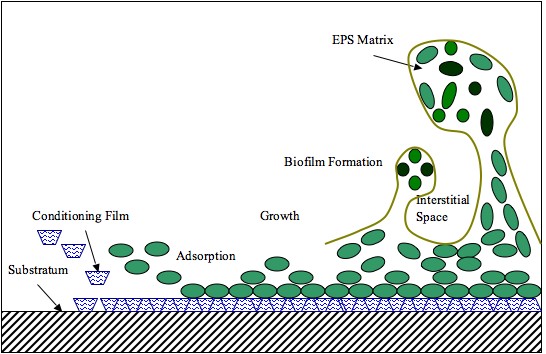 Biofouling or biological fouling is the accumulation of microorganisms, plants, algae, or animals on wetted surfaces. Such accumulation is referred to as epibiosis when the host surface is another organism and the relationship is not parasitic.
Biofouling or biological fouling is the accumulation of microorganisms, plants, algae, or animals on wetted surfaces. Such accumulation is referred to as epibiosis when the host surface is another organism and the relationship is not parasitic.Marine biofouling is caused by the adhesion of barnacles,
macroalgae and microbial slimes. It is a worldwide problem
in marine systems, costing the US Navy alone an estimated
$1 billion per annum. On ships’ hulls, biofouling
results in an increase in roughness, which in turn leads to
an increase in hydrodynamic drag as the vessel moves
through water. Increased fuel consumption, hull cleaning,
paint removal and repainting, and associated environmental
compliance measures all contribute to the costs of
biofouling.
According to some estimates, over 1700 species comprising over 4000 organisms are responsible for biofouling.
TYPES OF BIOFOULING
Biofouling is divided into two types:-
- Microfouling - (biofilm formation and bacterial adhesion)
- Macrofouling - (attachment of larger organisms)
(NOTE :- Biofilm is the assemblage of the attached cells.)
PROCESS OF FOULING
Marine fouling is typically described as following four stages of ecosystem development :-
The chemistry of biofilm formation describes the initial steps prior to colonization.
- Within the first minute the Van-der-waals interaction causes the submerged surface to be covered with a conditioning film of organic polymers.
- In the next 24 hours, this layer allows the process of bacterial adhesion to occur, with both diatoms and bacteria (e.g. Vibrio alginolyticus, Pseudomonas putrefaciens) attaching, initiating the formation of a biofilm.
- By the end of the first week, the rich nutrients and ease attachment into the biofilm allow secondary colonizers of spores of macroalgae (e.g. Enteromorpha intestinalis, ulothrix) and protozoans (e.g. Vorticella, Zoothamnium sp.) have attached themselves.
- Within 2 to 3 weeks, the tertiary colonizers (Macrofoulers) have attached including tunicates, molluscs and sessile Cnidarians.

METHODS OF FOULING CONTROL
The major types of toxic anti-fouling paints in use today
are soluble matrix paints, also known as conventional
paints, ablative paints (modern versions of conventional
paints) and self-polishing systems. The majority of
antifouling paints are pigmented with copper, usually as
cuprous oxide.
The self-polishing co-polymer (SPC) paints, introduced in
1974, were so called to indicate the ‘polishing’ effect as the
polymer dissolves away during normal vessel operation,
 releasing tributyltin (TBT). TBT kills settling fouling
releasing tributyltin (TBT). TBT kills settling foulingorganisms and, at the same time, the surface becomes
smoother. Being very lipid soluble, it is rapidly taken up by cells, where it inhibits energy transfer processes in respiration and photosynthesis. The SPC system was extremely successful, but TBT was shown to effect non-target organisms, including a number of shellfish, at levels much lower than ever envisaged.
TBT is now prohibited in many parts of the world and it
is anticipated that the International Maritime Organisation (IMO) will impose a worldwide ban on the use of TBT-containing paints on any type of vessel from January 2003. Furthermore, the discharge of copper from antifouling paints is currently under scrutiny, especially in California.
Silicon fouling release coatings have been developed as an
alternative to biocide-containing paints. They function by
minimising the adhesion strength of attached organisms, which are removed as the vessel moves through the water or by special cleaning procedures.
Silicon elastomers are also expensive and prone to tearing, so are only employed at the present time for specific
applications, such as on high speed vessels (where release of biofouling is effective) and in locations where toxic paints are prohibited. Research is underway to improve our understanding of the interactions between biological glues and fouling release surfaces, with the goal of improving performance and durability.
In today's climate, a potential fouling control agent must have a good mammalian and ecotoxicological profile. One such compound is zosteric acid, a sulphoxy phenolic acid derived from eelgrass (Zostera marina), which inhibits the accumulation of fouling by interfering with adhesion. Another approach is to synthesize ‘non-stick’ polymers that have the same surface properties as those organisms that remain foulant free.
IMPACTS OF BIOFOULING
Governments and industry spend more than US $ 5.7 billion annually to prevent and control marine biofouling.
Biofouling occurs everywhere but is most significant
economically to the shipping industries, since high levels of
fouling on a ship's hull significantly increases drag, reducing
the overall hydrodynamic performance of the vessel and
increases the fuel consumption. Biofouling is also found in
almost all circumstances where water based liquids are in
contact with other materials. Industrially important impacts
are on the maintenance of mariculture, membrane systems
(e.g., membrane bioreactors and reverse osmosis spiral wound membranes) and cooling water cycles of large industrial equipment and power stations. Biofouling can occur in oil pipelines carrying oils with entrained water especially those carrying used oils, cutting oils, oils rendered water-soluble through emulsification, and/or hydraulic oils.
The severe impact due to biofouling is on the speed of marine vessels. In some instances the hull structure and propulsion systems can become damaged.
Over time, the accumulation of biofoulers on hulls increases both the hydrodynamic volume of a vessel and the frictional effects leading to increased drag of up to 60%. The additional drag can decrease speeds up to 10%, which can require up to a 40% increase in fuel to compensate.
Increased fuel use due to biofouling contributes to adverse
environmental effects and is predicted to increase emissions of carbon dioxide and sulfur dioxide between 38 and 72 percent by 2020.





No comments:
Post a Comment